
The Paleogene Period is a geologic period and system that spans 43 million years from the end of the Cretaceous Period 66 million years ago (Mya) to the beginning of the Neogene Period 23.03 Mya. It is the first part of the Cenozoic Era of the present Phanerozoic Eon. The earlier term Tertiary Period was used to define the span of time now covered by the Paleogene Period and subsequent Neogene Period; despite no longer being recognized as a formal stratigraphic term, "Tertiary" still sometimes remains in informal use. Paleogene is often abbreviated "Pg", although the United States Geological Survey uses the abbreviation "Pe" for the Paleogene on the Survey's geologic maps.
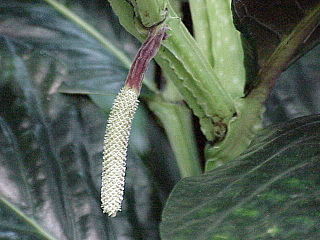
Piper, the pepper plants or pepper vines, is an economically and ecologically important genus in the family Piperaceae.

An apricot is a fruit, or the tree that bears the fruit, of several species in the genus Prunus.
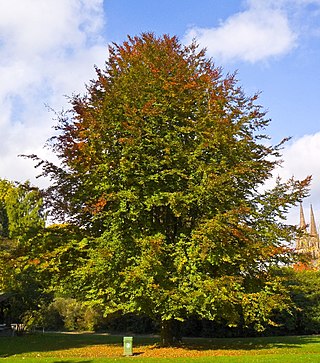
The Fagaceae are a family of flowering plants that includes beeches, chestnuts and oaks, and comprises eight genera with about 927 species. Fagaceae in temperate regions are mostly deciduous, whereas in the tropics, many species occur as evergreen trees and shrubs. They are characterized by alternate simple leaves with pinnate venation, unisexual flowers in the form of catkins, and fruit in the form of cup-like (cupule) nuts. Their leaves are often lobed, and both petioles and stipules are generally present. Their fruits lack endosperm and lie in a scaly or spiny husk that may or may not enclose the entire nut, which may consist of one to seven seeds. In the oaks, genus Quercus, the fruit is a non-valved nut called an acorn. The husk of the acorn in most oaks only forms a cup in which the nut sits. Other members of the family have fully enclosed nuts. Fagaceae is one of the most ecologically important woody plant families in the Northern Hemisphere, as oaks form the backbone of temperate forest in North America, Europe, and Asia, and are one of the most significant sources of wildlife food.

Cycads are seed plants that typically have a stout and woody (ligneous) trunk with a crown of large, hard, stiff, evergreen and (usually) pinnate leaves. The species are dioecious, that is, individual plants of a species are either male or female. Cycads vary in size from having trunks only a few centimeters to several meters tall. They typically grow very slowly and live very long. Because of their superficial resemblance, they are sometimes mistaken for palms or ferns, but they are not closely related to either group.

The rosefinches are a genus, Carpodacus, of passerine birds in the finch family Fringillidae. Most are called "rosefinches" and as the word implies, have various shades of red in their plumage. The common rosefinch is frequently called the "rosefinch". The genus name is from the Ancient Greek terms karpos, "fruit", and dakno, "to bite".
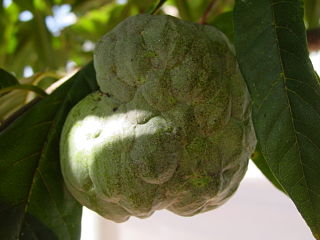
The Annonaceae are a family of flowering plants consisting of trees, shrubs, or rarely lianas commonly known as the custard apple family or soursop family. With 108 accepted genera and about 2400 known species, it is the largest family in the Magnoliales. Several genera produce edible fruit, most notably Annona, Anonidium, Asimina, Rollinia, and Uvaria. Its type genus is Annona. The family is concentrated in the tropics, with few species found in temperate regions. About 900 species are Neotropical, 450 are Afrotropical, and the remaining are Indomalayan.

Dipterocarpaceae is a family of 16 genera and about 695 known species of mainly lowland tropical forest trees. Their distribution is pantropical, from northern South America to Africa, the Seychelles, India, Indochina, Indonesia, Malaysia and Philippines. The greatest diversity of Dipterocarpaceae occurs in Borneo.
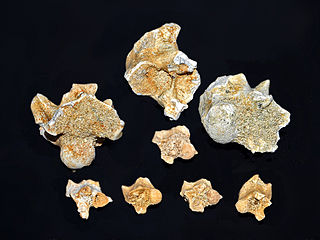
Palaeophis is an extinct genus of marine snake that is the type genus of the extinct snake family Palaeophiidae.
The Paleocene, or Palaeocene, is a geological epoch that lasted from about 66 to 56 million years ago (mya). It is the first epoch of the Paleogene Period in the modern Cenozoic Era. The name is a combination of the Ancient Greek παλαιός palaiós meaning "old" and the Eocene Epoch, translating to "the old part of the Eocene".

Shinisauria is a clade or evolutionary grouping of anguimorph lizards that includes the living Chinese crocodile lizard Shinisaurus and several of its closest extinct relatives. Shinisauria was named in 2008 by Jack Lee Conrad as a stem-based taxon to include all anguimorphs more closely related to Shinisaurus than to Anguis fragilis, Heloderma suspectum or Varanus varius. Several recent phylogenetic analyses of lizard evolutionary relationships place Shinisauria in a basal position within the clade Platynota, which also includes monitor lizards, helodermatids, and the extinct mosasaurs. Shinisaurians were once thought to be closely related to the genus Xenosaurus, but they are now considered distant relatives within Anguimorpha. The fossil record of shinisaurians extends back to the Early Cretaceous with Dalinghosaurus, which is from the Aptian aged Yixian Formation of China. Two other extinct shinisaurians are currently known: Bahndwivici from the Eocene of Wyoming and Merkurosaurus from the Late Oligocene of Germany and the Early Miocene of the Czech Republic. An indeterminate shinisaurian is known from an isolated tail found in the Eocene aged Messel pit in Germany.
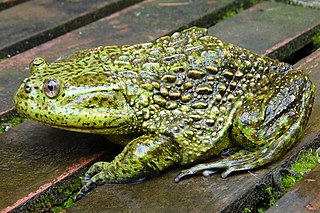
The Calyptocephalellidae are a family of toads found in Chile containing two living genera, Calyptocephalella and Telmatobufo.

The Cretaceous–Paleogene (K–Pg) extinction event, also known as the Cretaceous–Tertiary(K–T)extinction, was a sudden mass extinction of three-quarters of the plant and animal species on Earth, approximately 66 million years ago. The event caused the extinction of all non-avian dinosaurs. Most other tetrapods weighing more than 25 kilograms also became extinct, with the exception of some ectothermic species such as sea turtles and crocodilians. It marked the end of the Cretaceous period, and with it the Mesozoic era, while heralding the beginning of the Cenozoic era, which continues to this day.
This article records new taxa of fossil plants that are scheduled to be described during the year 2019, as well as other significant discoveries and events related to paleobotany that are scheduled to occur in the year 2019.
This article records new taxa of fossil plants that are scheduled to be described during the year 2020, as well as other significant discoveries and events related to paleobotany that are scheduled to occur in the year 2020.
Liriodendrites is an extinct genus of plants, known from fossil leaves. These have a forked apex (bifurcate), like those of extant species of Liriodendron. They have been interpreted as transitional between the leaves of the extinct genus Liriophyllum and Liriodendron. The genus has been placed in the family Magnoliaceae. Five species are known: L. aeternus, L. bradacii, L. laramiense, L. occidentalis and L. sachalinensis. It has been discovered in the United States, Egypt and Russia.
The paleoflora of the Eocene Okanagan Highlands includes all plant and fungi fossils preserved in the Eocene Okanagan Highlands Lagerstätten. The highlands are a series of Early Eocene geological formations which span an 1,000 km (620 mi) transect of British Columbia, Canada and Washington state, United States and are known for the diverse and detailed plant fossils which represent an upland temperate ecosystem immediately after the Paleocene-Eocene thermal maximum, and before the increased cooling of the middle and late Eocene to Oligocene. The fossiliferous deposits of the region were noted as early as 1873, with small amounts of systematic work happening in the 1880-90s on British Columbian sites, and 1920-30s for Washington sites. A returned focus and more detailed descriptive work on the Okanagan Highlands sites revived in the 1970's. The noted richness of agricultural plant families in Republic and Princeton floras resulted in the term "Eocene orchards" being used for the paleofloras.
This article records new taxa of fossil plants that are scheduled to be described during the year 2021, as well as other significant discoveries and events related to paleobotany that are scheduled to occur in the year 2021.
This paleobotany list records new fossil plant taxa that were to be described during the year 2022, as well as notes other significant paleobotany discoveries and events which occurred during 2022.
This is an overview of the paleoflora of the Eocene Messel Formation as explored by the Messel Pit excavations in Germany. A former quarry and UNESCO World Heritage Site, the Messel Formation preserves what once were a series of lakes surrounded by sub-tropical rainforest during the Middle Eocene, approximately 47 Ma.












